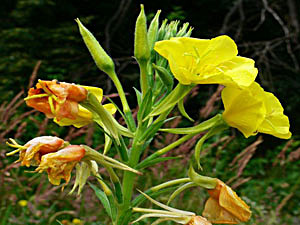
medicinal herbs
Evening Primrose
Oenothera biennis

Herb: Evening Primrose
Latin name: Oenothera biennis
Synonyms: Onagra biennis
Family: Onagraceae (Evening Primrose Family)
Medicinal use of Evening Primrose:
The bark and the leaves are astringent and sedative. They have proved of use in the treatment of gastro-intestinal disorders of a functional origin, whooping cough and asthma. A syrup made from the flowers is also an effective treatment for whooping cough. The bark is stripped from the flowering stem and dried for later use, the leaves are also harvested and dried at this time. Evening primrose oil has become a well-known food supplement since the 1980"s. Research suggests that the oil is potentially very valuable in the treatment of multiple sclerosis, pre-menstrual tension, hyperactivity etc. It is also taken internally in the treatment of eczema, acne, brittle nails, rheumatoid arthritis and alcohol-related liver damage. Regular consumption of the oil helps to reduce blood cholesterol levels and lower the blood pressure. The seed is a good source of gamma-linolenic acid, an unsaturated fatty acid which assists the production of hormone-like substances. This process is commonly blocked in the body, causing disorders that affect the uterine muscles, nervous system and metabolism. The poulticed root is applied to piles and bruises. A tea made from the roots is used in the treatment of obesity and bowel pains.Description of the plant:

Plant:
Biennial
Height:
120 cm(4 feet)

Flowering:
June toSeptember

Scent:
ScentedBiennial
Habitat of the herb:
Dunes, roadsides, railway banks and waste places in Britain, often in sandy soils.Edible parts of Evening Primrose:
Root - cooked. Boiled and eaten like salsify. Fleshy, sweet and succulent. Wholesome and nutritious. A peppery taste. The taste somewhat resembles salsify or parsnips. Young shoots - raw or cooked. Mucilaginous, with a peppery flavour, they are best used sparingly. Another source suggests that the shoots should not be eaten. Flowers - sweet. Used in salads or as a garnish. Young seedpods - cooked. Steamed. The seed contains 28% of a drying oil. It is edible and a very good source of gamma-linolenic acid, an essential fatty acid that is not found in many plant sources and has numerous vital functions in the body. The seed, however, is very small and difficult to harvest, it has to be done by hand. Overall yields are low, making the oil very expensive to produce.Other uses of the herb:
The oil from the seed is added to skin preparations and cosmetics. It is often combined with vitamin E to prevent oxidation. A yellow dye is obtained from the flowers. A finely ground powder made from the flowering stems is used cosmetically in face-masks to counteract reddened skins.Propagation of Evening Primrose:
Seed - sow in situ from late spring to early summer.Cultivation of the herb:
Dunes, roadsides, railway banks and waste places in Britain, often in sandy soils.Known hazards of Oenothera biennis:
None knownPlant information taken from the Plants For A Future.
